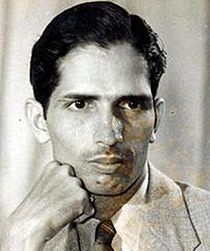K. K. Hebbar
| K.K.Hebbar | |
|---|---|

K K Hebbar in Bombay on 11 December 1945.
|
|
| Born |
Kattingeri Krishna Hebbar 1911 Kattingeri, near Udupi, Karnataka, India |
| Died | 1996 |
| Nationality | Indian |
| Education |
Académie Julian J. J. School of Art |
| Known for | Painting |
| Awards |
Padma Bhushan Padma Shri Fellowship of the Lalit Kala Akademi |
Kattingeri Krishna Hebbar (1911–1996) better known as K.K. Hebbar was a celebrated artist known for his India themed artworks.
Kattingeri Krishna Hebbar was born in 1911 in Kattingeri near Udupi, India in a Tulu speaking Brahmin family. Hebbar was inclined towards art from his childhood, because his father was an occasional sculptor who used to make Ganesha idols. Coming from an artistic family background Hebbar pursued art and formally studied at the J. J. School of Art (Sir Jamsetjee Jeejebhoy School of Art) in Mumbai between 1940-1945. Later he studied art at the Académie Julian in Paris. He was corresponding Member of the Academy of Arts, Berlin between 1975-1993.
Hebbar's early artwoks were called his Kerala phase because of his depiction of the landscapes of the regions of Malabar and Tulu Nadu. Later he experimented with other themes. His artworks were inspired by Paul Gauguin and Amrita Sher-Gil. He first won international audiences at the Art Now In India exhibitions in 1965 which were held in London and Brussels. Hebbar participated in various International art exhibitions like the Venice Biennale, São Paulo Art Biennial and Tokyo Biennale. Today, his artworks are considered highly influential in Indian Art History.
Hebbar won many awards throughout his lifetime including India's fourth and third highest civilian awards the Padma Shri and the Padma Bhushan. Other of his awards include Academy of Fine Arts, Kolkata, the Bombay Art Society Award, the Bombay State Award, the Lalit Kala Akademi Award, Varna Shilpi K Venkatappa Award, an honorary doctorate from Mysore University, Soviet Land Nehru Award.
...
Wikipedia
